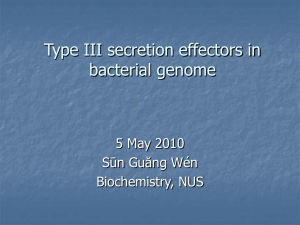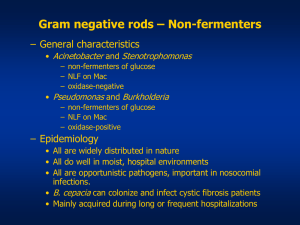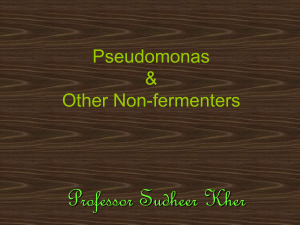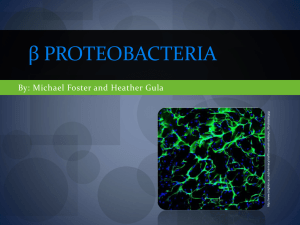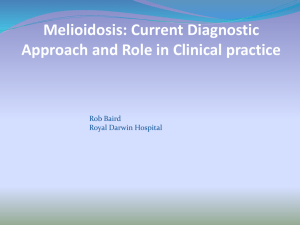Australian Tropical Bacteriology
advertisement
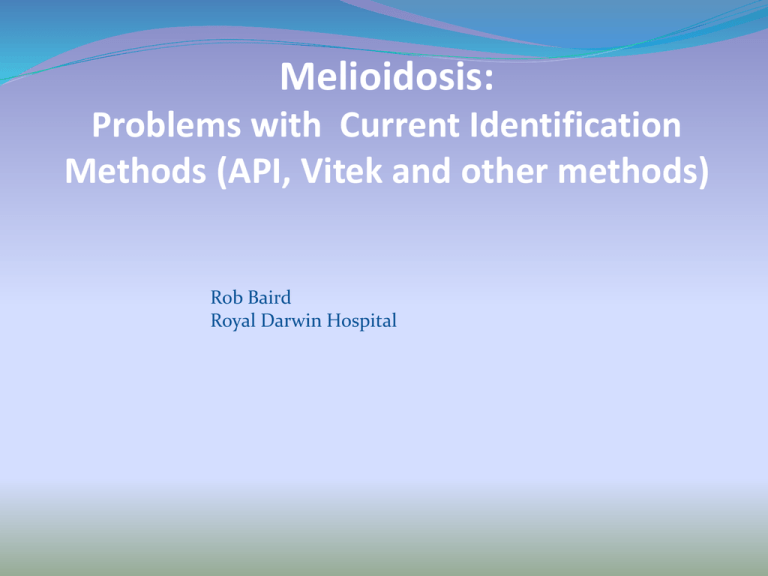
Melioidosis: Problems with Current Identification Methods (API, Vitek and other methods) Rob Baird Royal Darwin Hospital Christoph Weissert, et al Emerging Infec Dis Volume 15, Number 11—November 2009 or J Med Microbiol. 2012 Oct;61(Pt 10):1483-4.Epub 2012 Jul 19. Common phenotypic mis-identifications of B. pseudomallei are primarily due to: Regional biochemical differences in B. pseudomallei strains Lack of the regional biochemical profiles in the phenotypic databases A proliferation of taxonomic change in the genus, occurring well ahead of phenotypic database updates and Ashdown’s media: growth not limited to B. pseudomallei. Coliforms, yeast, S. maltophilia, Pseud sp. and B. cepacia can all grow. Can survive the decontamination process of TB and grows quite well on the media used making isolation of TB difficult. Mass spectrometry, while an excellent aid in diagnosis, is dependent on the quality of the protein spectra database of the instrument. Misidentification has been reported in the literature. Currently 85 Burkholderia are taxonomically recognised Burkholderia acidipaludis Burkholderia ambifaria Burkholderia andropogonis Burkholderia anthina Burkholderia hospita Burkholderia kururiensis Burkholderia lata Burkholderia latens Burkholderia soli Burkholderia sordidicola Burkholderia stabilis Burkholderia symbiotica Burkholderia arboris Burkholderia bannensis Burkholderia mallei Burkholderia terrae Burkholderia terricola Burkholderia brasilensis Burkholderia bryophila Burkholderia caledonica Burkholderia caribensis Burkholderia caryophylli Burkholderia cenocepacia Burkholderia metallica Burkholderia mimosarum Burkholderia multivorans Burkholderia nodosa Burkholderia norimbergensis Burkholderia oklahomensis Burkholderia thailandensis Burkholderia cepacia Burkholderia cepacia complex Burkholderia oxyphila Burkholderia vietnamiensis Burkholderia phenazinium Burkholderia phenoliruptrix Burkholderia phymatum Burkholderia phytofirmans Burkholderia pickettii Burkholderia plantarii Burkholderia xenovorans Burkholderia zhejiangensis "Candidatus Burkholderia calva" "Candidatus Burkholderia crenata" "Candidatus Burkholderia hispidae" "Candidatus Burkholderia kirkii" Burkholderia pseudomallei "Candidatus Burkholderia mamillata "Candidatus Burkholderia nigropunctata" "Candidatus Burkholderia rigidae" "Candidatus Burkholderia schumannianae" "Candidatus Burkholderia verschuerenii" "Candidatus Burkholderia virens" Burkholderia cocovenenans Burkholderia contaminans Burkholderia denitrificans Burkholderia diazotrophica Burkholderia diffusa Burkholderia dolosa Burkholderia endofungorum Burkholderia ferrariae Burkholderia fungorum Burkholderia ginsengisoli Burkholderia gladioli Burkholderia glathei Burkholderia glumae Burkholderia graminis Burkholderia grimmiae Burkholderia heleia Burkholderia megapolitana Burkholderia pyrrocinia Burkholderia rhizoxinica Burkholderia sabiae Burkholderia sacchari Burkholderia sartisoli Burkholderia sediminicola Burkholderia seminalis Burkholderia silvatlantica Burkholderia singaporensis Burkholderia solanacearum Burkholderia tropica Burkholderia tuberum Burkholderia ubonensis Burkholderia unamae Burkholderia vandii Regional differences Comparison of the VITEK 2 system biochemical profiles of 68 confirmed B. pseudomallei clinical strains from hospitals in Sabah and Sarawak, Malaysian Borneo with 149 B. pseudomallei and 18 B. cepacia isolates from the Royal Darwin Hospital (RDH) in the Northern Territory, Australia. One isolate per patient was analyzed. All isolates were collected between September 2010 and June 2012 except for 17 isolates collected in 1994 from Sabah. Regional differences Typical/usual B. pseudomallei profile: 88% of isolates with BNAG identified correctly, only 13% without BNAG identified correctly B A C D Figure 1. Nonmetric multidimensional scaling (nMDS) ordination on the Euclidean distance resemblance matrix of the Vitek-2 biochemical profile of 235 B. pseudomallei and B. cepacia isolates from Australia and Malaysian Borneo. (A) Samples were identified as either B. pseudomallei, B. cepacia, B. pseudomallei misidentified as B. cepacia or isolates with low discrimination. (B) The bubble size reflects the presence (large) or absence (small) of BNAG substrate in an isolate. (C) Analysis based on isolates from both countries, Australia and Malaysia. (D) The bubble size reflects the presence (large) or absence (small) of NAGA substrate in an isolate. Abbreviations: Bps, B. pseudomallei; Bcep, B. cepacia; Bcep misID, B. pseudomallei misidentified as B. cepacia; BNAG, β-N-acetyl-glucosaminidase; NAGA, Nacetylgalactosamine. Unfamiliarity with B. pseudomallei and problems with inaccurate speciation using some automated commercial biochemical identification systems have resulted in laboratories misidentifying the bacterium as a Pseudomonas or other Burkholderia species. Confirmation of B. pseudomallei identity by real-time polymerase chain reaction (PCR) of DNA extracted from cultured bacterial colonies is increasingly the standard for many laboratories. Various genetic targets have been published for PCR identification of B. pseudomallei from bacterial cultures and also for direct detection from clinical samples, with a recent review showing the TTS1-orf2 assay to be superior in detecting B. pseudomallei directly from clinical specimens. Apart from molecular methods, B. pseudomallei from cultures can also be confirmed by antigen detection assays such as latex agglutination. More recently matrix-assisted laser desorption ionization-time of flight Mass Spectrometry (Maldi-TOF MS) has been adapted to identify cultured bacteria based on protein fingerprint profiles. Common phenotypic mis-identifications of B. pseudomallei are primarily due to: Regional biochemical differences in B. pseudomallei strains Lack of the regional biochemical profiles in the phenotypic databases A proliferation of taxonomic change in the genus, occurring well ahead of phenotypic database updates The move towards genotypic and molecular identification, as the gold standard, will reduce this problem for reference labs, but local labs still require a high index of clinical and microbiological suspicion, when identifying Burkholderia isolates from patients with compatible clinical illnesses and Ashdown’s media: growth not limited to B. pseudomallei. Coliforms, yeast, S. maltophilia, Pseud sp. and B. cepacia can all grow. Can survive the decontamination process of TB and grows quite well on the media used making isolation of TB difficult. Mass spectrometry, while an excellent aid in diagnosis, is dependent on the quality of the protein spectra database of the instrument. Misidentification has been reported in the literature.
